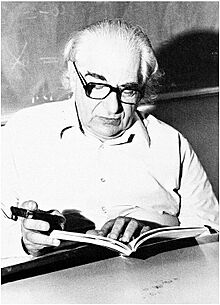Mário Schenberg facts for kids
Quick facts for kids
Mário Schenberg
|
|
|---|---|
 |
|
| Born |
Mayer Schönberg
July 2, 1914 |
| Died | November 10, 1990 (aged 76) |
| Alma mater | University of São Paulo |
| Known for | Schönberg-Chandrasekhar limit Urca process |
| Scientific career | |
| Fields | Theoretical physics |
| Doctoral students | José Leite Lopes |
| Notes | |
|
Brazilian physicist of the 'heroic era' (1900–1945), together with José Leite Lopes, Cesar Lattes, Jayme Tiomno, and Joaquim da Costa Ribeiro.
|
|
Mário Schenberg (born Mayer Schönberg; July 2, 1914 – November 10, 1990) was a brilliant Brazilian scientist. He was an electrical engineer, a physicist, an art critic, and a writer. He is known for his important work in understanding how stars work.
Contents
Early Life and Education
Mário Schenberg was born in Recife, Brazil. His family had come from Russia and Germany. From a young age, he was very good at mathematics. He especially loved geometry, which is the study of shapes and spaces. This love for geometry influenced his later scientific work.
He finished his early schooling in Recife. Because his family didn't have a lot of money, he couldn't go to study in Europe. Instead, he started studying engineering at the Faculty of Engineering of Recife in 1931.
Amazing Discoveries in Physics
Mário Schenberg is considered one of Brazil's most important theoretical physicists. He made big contributions to astrophysics, which is the study of stars and space. He helped us understand how giant stars explode.
The Urca Process
Schenberg helped explain a process called the Urca process. This is a cycle of nuclear reactions that happens inside very large stars. In this process, a star's core loses energy very quickly. This loss of energy makes the star collapse and then explode as a supernova. A supernova is a huge, bright explosion of a star.
The famous physicist George Gamow named this process "Urca." He got the idea from Schenberg. Schenberg joked that "the energy disappears in the nucleus of the supernova as quickly as the money disappeared at that roulette table" at a casino in Rio de Janeiro called Urca.
The Schönberg–Chandrasekhar Limit
In 1942, Schenberg worked with an Indian physicist named Subrahmanyan Chandrasekhar. Together, they discovered something called the Schönberg–Chandrasekhar limit. This limit describes the maximum size of a star's core. If the core gets too big after it runs out of hydrogen fuel, it can't support the outer parts of the star. This leads to the star collapsing under its own gravity.
Quantum Physics and Geometry
At the University of São Paulo, Schenberg worked closely with physicist David Bohm. In 1954, Schenberg showed a connection between how tiny particles move and Bohm's theories.
Schenberg also wrote important papers in the late 1950s about "geometric algebras." These are special types of mathematical systems. He showed how these algebras are connected to quantum physics and quantum field theory. These ideas helped other scientists, like Basil Hiley, in their work on understanding quantum mechanics using algebra. Schenberg's work is still important for mathematicians and physicists today.
Life and Politics
Mário Schenberg was a professor at the University of São Paulo. He was also a member of the Brazilian Communist Party. This was a political group that believed in a society where everyone is equal and resources are shared.
Legacy
Mário Schenberg's work continues to inspire scientists. A special detector designed to find gravitational waves is named after him. It is called the Mario Schenberg Graviton.

